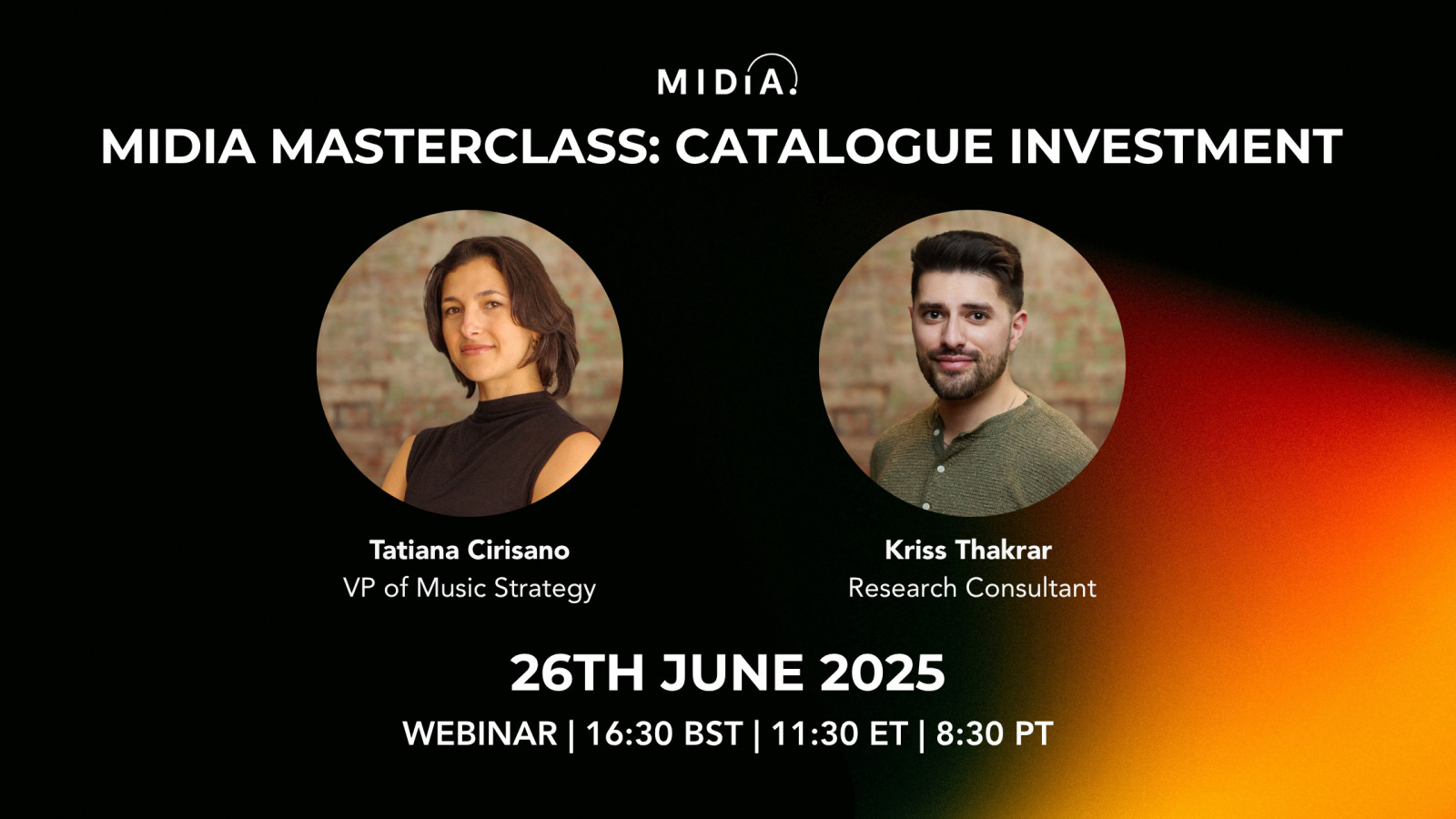The ghost of the 2000s lingers over the catalogue acquisition market

Photo: Clay Banks

Sign up here for MIDiA’s Masterclass webinar on catalogue investment, this Thursday June 26, 2025, with Kriss Thakrar and Tatiana Cirisano.
In the second quarter of 2025, a range of catalogue acquisition deals have broken the typical mould:
- Sony acquired Hipgnosis Songs Group from Recognition Music Group, and its Japan division acquired full rights to Spookiz animation franchise
- Create Music Group acquired K7! and Monstercat, and struck a JV with EZMNY Records
- Exceleration acquired Cooking Vinyl
- Concord acquired Broadway Licensing Global
- Pophouse acquired Swedish House Mafia’s label Axtone
- Reservoir launched PopIndia and made its first acquisition in Musicraft
- Chord Music Partners acquired Morgan Wallen’s label Big Loud for $200m
- Warner music acquired Zach Bryan’s catalog for $350m
- DJ Khaled struck a catalog and JV deal with Influence Media
- Taylor Swift got her masters back
There is a clear theme with these deals – most are for labels or publishers rather than individuals. Whilst these types of acquisitions are nothing new, their weight against individual deals is a shift in the acquisition market.
2024 was dominated by headlines for blockbuster $100m+ deals for rights from icons including Michael Jackson, Pink Floyd, Queen, Kiss, and Rod Stewart. Beyond this, individual deals with artists and songwriters far outweighed the number of deals for labels and publishers.
So what is going on with this flurry of label and publishing deals? The answer is a combination of supply, demand, and the legacy left by the industry of old.
Featured Report
Streaming strongholds High-potential markets for global music players
While the balance of music streamers continues to tip towards global south markets, their smaller ARPU rates limit their revenues. Meanwhile, periodic price-rises and the advent of supremium will reinforce the contributions from the West. This report highlights streaming strongholds, those markets which, underscored by high music engagement and his...
Find out more…A push for modern icons
It is easy to assume there is always a superstar somewhere ready to sell at the right price. However, the growth of catalogue acquisitions in the past five years has largely focused on the fight for older industry icons. As a result, these icons have commanded bidding wars that have hiked up their value and with each passing sale, the increasing scarcity of superstars remaining in the market only serves to maintain or increase those prices.
This has pushed the catalogue acquisition space into new frontiers, and as MIDiA suggested in our 2022 ‘Music catalogue acquisition’ report, a new focus on modern icons was overdue. That has since unfolded. In MIDiA Research’s latest catalogue acquisition tracker of public deals, hip hop, electronic and Latin genres, such as reggaeton, grew their share. Meanwhile, rock saw the biggest decline in share of deals (while still commanding the highest share overall).
The noughties industry legacy
There are a couple of key reasons why this increasing focus on modern icons centres labels and publishers rather than individual artists and songwriters. The first is that a generation of US legacy acts who released music between 1978 and 1990, as well as those prior to 1969, are eligible for rights reversion. Despite significant hurdles to overcome with rightsholders, legacy artists have the opportunity to bring their rights back under their ownership, or at the very least, renegotiate the terms of their deal.
However, the reversion of rights enabled by the 1976 US Copyright Act is irrelevant for most icons in hip hop, electronic music, and reggaeton. 2000-2010 deals have their reversion window in 2035-2045, which provides a 10 to 20-year horizon before reversion comes into play.
A more important factor than reversions is, as Jonathan Dickens, Adele’s manager, put it in a recent interview with Music Business Worldwide, that many artists signed deals at a “slave rate” prior to 2010. This means that the rights of popular music from the 2000s, which make up nearly a quarter of our tracked deals, have heavy interests in the hands of labels and publishers.
The unfolding market
Despite the noughties legacy, some modern stars like Justin Bieber, Kevin Parker of Tame Impala, and Katy Perry have significant enough interests in their rights to make it worthwhile to sell. However, in reality, only a slim number of acquirers are directly going after modern superstars.
Most competition is happening in the $25-$50M range, in part because of the Asset Backed Securities (ABS) market. These ABS funds, which are growing more popular, need to develop a portfolio of assets that is well diversified by age / genre / rights / etc. Essentially, it is in their interest to acquire a label or publisher rather than a single artist, and naturally, more attention on the labels and publishers that hold the best deals.
There is no escaping the ghosts of the music industry’s past in the world of catalogue acquisitions. The past few years have seen a noughties revival on both sides of creation and consumption that is only going to put more spotlight on acquiring music from this era. Furthermore, as music consumption continues to fragment, the 2000s and 2010s may constitute the “last eras” of global superstars, making these catalogues even more valuable with time.
An industry seeing slowing streaming growth and an intense focus on market share, alongside more players raising money and competing for deals than ever, is set to fuel a new phase of acquisitions. This means the heat of the catalogue market is not going away, especially for rightsholders who hold the biggest pieces of the noughties pie.

The discussion around this post has not yet got started, be the first to add an opinion.